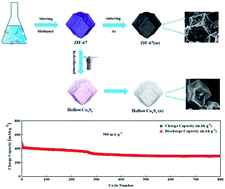Porous carbon-confined CoxSy nanoparticles derived from ZIF-67 for boosting lithium-ion storage†
Abstract
Reasonable regulation and synthesis of hollow nanostructure materials can provide a promising electrode material for lithium-ion batteries (LIBs). In this work, utilizing a metal–organic framework (MOF, ZIF-67) as the raw material and template, a composite of CoxSy with a carbon shell is successfully formed through a hydrothermal vulcanization and a subsequent high temperature sintering process. The as-obtained CoxSy(700) material sintered at 700 °C has a large specific surface area, and at the same time possesses a hollow carbon shell structure. Benefiting from unique structural advantages, the volume change during the electrochemical reaction can be well alleviated, and thus the structural stability is greatly improved. The presence of the carbon matrix can also offer sufficient ion/electron transfer channels, contributing to the enhanced electrochemical performance. As a result, the CoxSy(700) electrode can deliver an excellent capacity of 875.6 mA h g−1 at a current density of 100 mA g−1. Additionally, a high-capacity retention of 88% is achieved after 1000 cycles when the current density is increased to 500 mA g−1, and exhibiting a prominent rate capability of 526.5 mA h g−1, simultaneously. The novel synthesis route and considerable electrochemical properties presented by this study can afford guidance for the exploration of high-performance cobalt sulfide anodes in LIBs.



 Please wait while we load your content...
Please wait while we load your content...